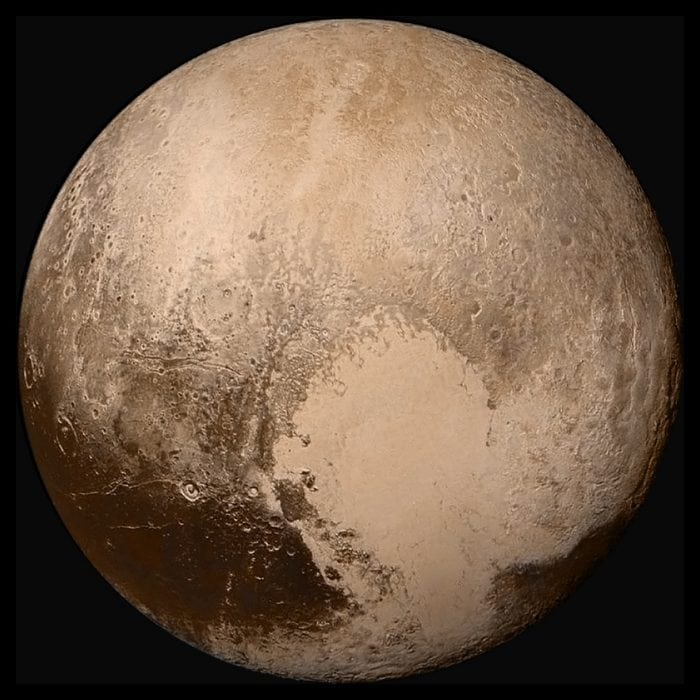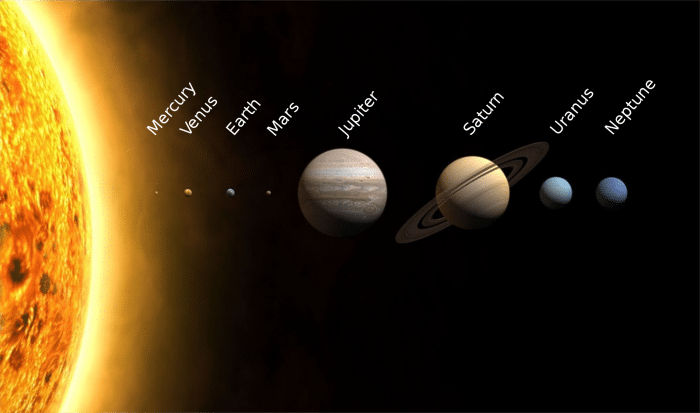
A new study claims that everyone’s favorite tiny planet, Pluto, should have never been classified as a dwarf planet over a decade ago. As many of you might remember, 12 years ago in 2006 Pluto had its planet credentials yanked and had a “dwarf planet” sticker slapped on it by the Internation Astronomical Union (IAU), upsetting quite a few people (something that a lot of people have yet to get over to this day). The IAU is a group that names planetary bodies and they get to decide and creates rules that define what is (and isn’t) a planet. In 2006 the IAU defined a planet (which can be found on their website here):
A planet is a celestial body that (a) is in orbit around the Sun, (b) has sufficient mass for its self-gravity to overcome rigid body forces so that it assumes a hydrostatic equilibrium (nearly round) shape, and (c) has cleared the neighbourhood around its orbit
Pluto (a) does orbit the sun, (b) is round or has a nearly round shape, but it is that final criterion that got Pluto knocked off the list for being a planet. The IAU claimed that Pluto was simply too small to clear its neighborhood and knock debris and space rocks out of its path as it orbits the sun. But some scientists are now fighting back saying that reason doesn’t hold any weight to strip Pluto of its “planet card”.
The study (which can be found here), published in the scientific journal Icarus, delves into the scientific aspect of what a planet is and how science should classify a planet. Planetary scientist Philip Metzger from the University of Central Florida was the lead author on this study and he has had some serious issues with the IAU classifying Pluto as a dwarf planet. Metzger and his research team looked at centuries’ worth of research and found that the IAU based their criteria for the “clear the neighborhood around its orbit” from one source from the early 19th century.
They also found that the IAU did not take into account that in the 1950’s the standards for classifying planets changed thanks to Gerald Kuiper (the Kuiper belt that he discovered is named after him). Kuiper, who is considered to be the father of modern planetary science, believed that what determined whether something was or wasn’t a planet was how a celestial body actually formed. If the IAU used that as a standard then Pluto would still be a planet (more than likely). Metzger actually proposes in his research that a celestial body should be classified as a planet if it has enough gravity to be spherical in shape. He states, “It turns out this is an important milestone in the evolution of a planetary body, because apparently when it happens, it initiates active geology in the body.”
The idea of one governing body being able to vote to decide on whether or not a planet is a planet is also brought up in Metzger’s research. He does state that ultimately it needs to be scientists who decide whether or not a planet is a planet based on scientific evidence, not made by people based purely on a vote.
Here is some information about the planet Pluto:
- Orbital period: 248 Earth years = 1 full year on Pluto
- Pluto has 5 moons (largest is Charon)
- Was discovered on February 18, 1930, by Clyde Tombaugh in the Lowell Observatory
- Pluto is named after the Greek god of the underworld (Pluto is another name for Hades)
- Pluto was reclassified as a dwarf planet in 2006)
- Pluto is the largest dwarf planet in our solar system (we have 5 dwarf planets in our solar system)
The Other Planets In Our Solar System

Our solar system. Image source: via Wikipedia licensed under CC-BY-SA 3.0
I wanted to be a snowplow driver when I was a kid. Growing up in the Rocky Mountains, that’s the most glorious job you can imagine. But then my mother took me to a lecture about the solar system when I was 8, and I got hooked. Kip Thorne
If you are curious about the other planets in our solar system, we created a table below that covered the basics of the solar system (not including Pluto since we covered that already).
| The Planets of the Solar System | |||||
| Name | Date of Discovery | Orbit Period | Satellites? | Named After | Missions |
| Mercury | 14th century BC but it is unknown who discovered Mercury | 88 days = 1 year | None | Named after the Roman messenger Mercury because of its quick speed as it moved around the sun | Mariner 10 (1974 flyby), Messenger (2004 orbiter that crashed in 2015) |
| Venus | 17th century BC by Babylonian astronomers | 225 = 1 years | None | Venus is named after the Roman goddess of Love | Venera (1961), Mariner 2 (1962), Venera 4 (1967), Mariner 10 (1974), Venera 9 and 10 (1975), Venera 13 and 14 (1982), Pioneer Venus Orbiter and Multiprobe (1978), Venera 15 and 16 (1983), Vega 1 (1985), Vega 2 (1985), Galileo (1990), Magellan (1994), Cassini–Huygens (1998), and Messenger (2006) |
| Earth | Human creation | 365 days = 1 year | 1 | Earth is possibly named after the English and German words for ground, but the real truth is that no one really knows where the word “Earth” comes from. | Too many to count |
| Mars | 2nd millennia BC by Egyptian astronomers | 687 days = 1 year | 2: Phobos and Deimos | Mars is actually named after the Roman God of war, presumably because of Mars’ blood red color. | So far there have been over 50 missions to Mars with countless more planned |
| Jupiter | Sometime between the 7th and 8th century BC by Babylonian astronomers | 4,333 days = 1 year | 79 moons and 4 rings | Jupiter was named after the Roman sky god, Jupiter. It is a fitting name seeing as the planet is the largest planet in our solar system. | Pioneer 10, Pioneer 11, Voyager 1, Voyager 2, Galileo, Ulysses, Cassini-Huygens, New Horizons, Juno |
| Saturn | 8th century BC by Assyrians | 10,756 days = 1 year | 62 moons and over 30 rings | Saturn is named after the Roman god of agriculture (unknown why). | Pioneer 11, Voyager 1, Voyager 2, Cassini-Huygens |
| Uranus | March 1781 by William Herschel | 30,687 days = 1 year | 27 moons and 13 rings | Uranus is named after the Greek god of the sky who is the father of Saturn and the grandfather of Jupiter. | Voyager 2 |
| Neptune | September 1846 by Urbain Le Verrier and Johann Galle | 60,190 days = 1 year | 14 moons and 5 rings | Neptune is named after the Roman god of the sea because of its deep blue coloring | Voyager 2 |









